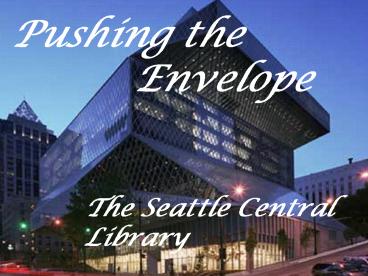Pushing the Envelope - PowerPoint PPT Presentation
1 / 19
Title:
Pushing the Envelope
Description:
Pushing the Envelope The Seattle Central Library Background In 1890, The Seattle Public Library was introduced by the Seattle city government. – PowerPoint PPT presentation
Number of Views:496
Avg rating:3.0/5.0
Title: Pushing the Envelope
1
Pushing the Envelope
The Seattle Central Library
2
Background
- In 1890, The Seattle Public Library was
introduced by the Seattle city government. - On January 2, 1901, an early morning fire
destroyed the Yesler Mansion, where the library
was located. - The community pleaded for funds to rebuild the
library at a new and permanent location. Andrew
Carnegie, whom helped construct libraries across
the country, donated 220,000 for the new
building. - In 1902, the city purchased an undeveloped
downtown block for 100,000 to become the new
site of the library. - In August 1903, the city selected P.J. Weber of
Chicago to design the building. - Construction began in 1905 and it opened in 1906.
3
Background
- In 1956, the city began setting the stage for a
new library to replace the unsightly and
inadequate Central Library Carnegie. - The second Central Library opened on March 26,
1960. - By the 1990s, planning for library improvements
were under way. - In November 1998, Seattle voters overwhelmingly
approved a 196.4 million Libraries for All
bond to build a new Central Library. - The Dutch architect Rem Koolhaas was chosen to
design the latest Seattle Central Library
4
- The Seattle Central Librarys goal was to
redefine/reinvent the library as an institution
no longer exclusively devoted to the book - as an
information store, where all media, new and old,
are presented under a regime of new equalities.
In an age when information can be accessed
anywhere, it is the simultaneity of all
media and the professionalism of their
presentation and interaction, that will make
the library new. - -Rem Koolhaas, Architect
5
An International Collaboration
- Office for Metropolitan Architecture
(Netherlands) - LMN Architects of Seattle
- Arup Offices (Los Angeles, London, San Francisco,
and New York) - Magnusson Klemenic Associates (Seattle)
6
Quick Facts
- Opened May 23, 2004
- 12 Story Structure
- covering 412,000 square feet
- Divided into 5 overlapping platforms
- 165.5 million project
- Features a Glass-covered atrium
- One of the largest structures certified by the US
Green Building Councils Leadership Energy and
Environmental Design program
7
How the Design Evolved
8
The Five Platforms
- The architects took into consideration the
distinct functions and areas of the library and
created these five platforms as boxes stacked
upon each other - Parking
- Public Spaces
- Information
- Collections
- Administration and Staff
- The boxes were repositioned to provide better
views and more light. - The administration section east to face 5th Ave.
Mt. Rainer, - other main boxes north to give views of Elliot
Bay from the reading rooms. - Moving the upper floors created more natural
light for the lower floors.
9
(No Transcript)
10
The Grid
- Lateral force resisting system
- In the early design the engineers attempted to
create a column-free design to maximize space. - The grid was developed to make this possible. The
mullions of the grid would be able to support the
force of the structure. - During testing the grid showed very good in-plane
strength to seismic forces. - This column-free design would have been very
expensive so the final design called for several
large columns between the platforms located
behind the grid.
11
The Megatrusses
- Protect the platforms from lateral movement by
transferring gravity to the perimeter columns or
internal trusses. - Because the seismic and gravity systems were
separated into the grid and megatrusses, it
enabled engineers to create a greater number of
unobstructed views and maximize the amount of
daylight.
12
The Footing
- The building is founded upon spread footing of 30
square feet x 7.5 feet thick. - It is able to hold a pressure up to 10,000 pounds
per square foot. - Under the stairway core there is a mat foundation
of 44 feet x 65 feet. It descends the full height
of the building. - There is a 28 feet wide combined footing that
supports two shear walls and a column.
13
The Use of Glass
- Engineers tried to find a glass that had a
maximum transparency and balanced with occupants
comfort levels with outside light. - They decided to use a high performance glazing on
the sunlit facades to improve energy efficiency.
A more transparent glazing was used on shaded
facades to create more natural light. - The glazing system includes metal mesh in between
two planes of glass. - 140,000 square feet of transparency glazing and
skylights.
14
(No Transcript)
15
Energy Saving Benefits
- To extract the full benefits of energy savings
from the design the buildings light control
system was designed with photocells that
automatically shut off artificial lighting when
the natural light level is adequate. - High velocity jet nozzles distribute conditioned
air directly onto the buildings glazing to offset
the facades heat gains and losses. - There are carbon-dioxide monitoring systems that
shut off the air ventilation system when
occupancy is low to save energy consumption.
16
Energy Saving Benefits
- An atrium economizer cycle draws air from
throughout the building to the top of the atrium
to the outside. Thermal energy will be extracted
and recovered through this cycle and used to
precondition the atrium. - To conserve water the library is installed with
low flow plumbing fixtures, a system for
collecting storm water, and a landscape
architecture program that emphasizes
drought-tolerant plants and trees. - Rain water is collected from the roof, treated,
and used to irrigate the buildings landscape.
17
Tour
- For a virtual tour
- http//seattletimes.nwsource.com/news/local/librar
y/
18
Questions?
19
Thank You
- Julianne Abe
- Brandon Estrella
- Happy Holidays

